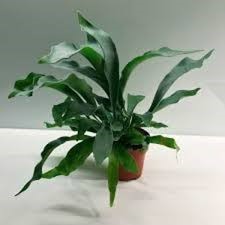By Marsha Krassner, Bexar County Master Gardener

credit: naturerabbit.in
One day about a year ago, I wandered into the greenhouse located at the back end of one of my favorite nurseries and saw a most other-worldly looking plant. I suspected that it was in the fern family and after consulting my trusty plant identifier and talking with one of the staff, I learned that it was a Staghorn Fern.
Native to tropical rain forests in Africa, Southeast Asia, and Australia, Staghorn Ferns are epiphytes, i.e., plants that grow on trees, branches or rocks and derive moisture and nutrients from the air and rain. Tropical forests are the ideal environment for epiphytes such as Staghorn Ferns, providing low light and constant moisture, which washes nutrients into the root area.
Depending on the source, there are between 17 and 20 different species of Staghorn Ferns (Platycerium alcicorne). Common names include Elkhorn Fern and Antelope Ears because of the distinctive shape of their fronds: each frond resembles the forked antlers of male deer or elk. The green, pronged antler fronds can reach up to three feet in length and even larger in their natural habitat.

credit: TheSpruce.com
Aside from the antler-like foliage, Staghorn Ferns also have flat, basal leaves known as shield fronds that cover the root ball structure and absorb the water and nutrients. Over time, the shield fronds turn brown and papery. In the year that I have tended to my Staghorn Fern, I have become used to seeing these flat brown-ish fronds and see that they have no ill effect on the plant; rather, they’ve served their purpose in providing water and food to support the growth of the more distinctive green fronds.
Staghorn Ferns were once considered difficult to grow, but today they are popular and can be successfully cultivated at home. In fact, these other-worldly ferns are well-suited to San Antonio’s climate. The plants grow outdoors in warm-season locations and indoors elsewhere. Because Staghorn Ferns are epiphytic, many people mount them on a wall, or in a hanging basket. Mine is in a clay pot outside on my front patio, and since it has nearly doubled in size since I brought it home, I plan to transfer it to a larger hanging basket.
How to Grow a Staghorn Fern
Staghorn Fern care relies on careful light, temperature, and moisture monitoring. The key to helping your Staghorn Fern thrive is to mimic its natural, sub-tropical conditions, as best as you can. Dappled sunlight that one might find on the bark of a tree below a canopy of leaves, combined with frequent moisture are the two essential ingredients to growing and maintaining a healthy Staghorn Fern.

Credit: S. P. Brown, UF/IFAS
Soil & Fertilizer
Staghorn Ferns need a little mound of peat, compost or another organic matter piled up under the plant. If you are mounting it onto a wooden plaque or a tree, tie the fern onto the growing medium with string, twine, or plant strips.
Experts suggest that the Staghorn Fern can be fed monthly with a well-balanced, water-soluble fertilizer, typically during the spring and summer when the fern is in an active growing stage. In one year of growing a Staghorn Fern, I’ve never fertilized it, yet it has more than doubled in size.
Light
Consistent, filtered light is best. I keep my Staghorn Fern in a mostly-shaded part of my garden that receives early morning sun. I cautiously watch it throughout the year as the light changes, making sure that it doesn’t get any lengthy periods of direct sunlight. That being said, Staghorn Ferns can handle more sunlight if given enough water and humidity. Just be cautious about allowing any direct rays to hit the fragile fronds, as they burn easily.
Water
I find that my Staghorn Fern likes to dry out between watering. During the cooler winter months, I only water it once every 2-3 weeks. In the hotter months, I water it at least once a week, taking care not to over-water.
Remember that Staghorn Ferns love humidity. Though a more mature Staghorn can survive briefly freezing temperatures, it thrives in warm, humid conditions. Care should be taken to maintain those conditions (at least above 50° F, and below 100° F), especially when they’re young.
If you see that the fronds have begun to brown or blacken towards the base of the plant, then it’s a clear sign of over-watering. Similarly, if the tips of the fronds begin to brown or wilt, it probably needs to be watered more frequently.
Have fun growing and maintaining this wonderful fern!
